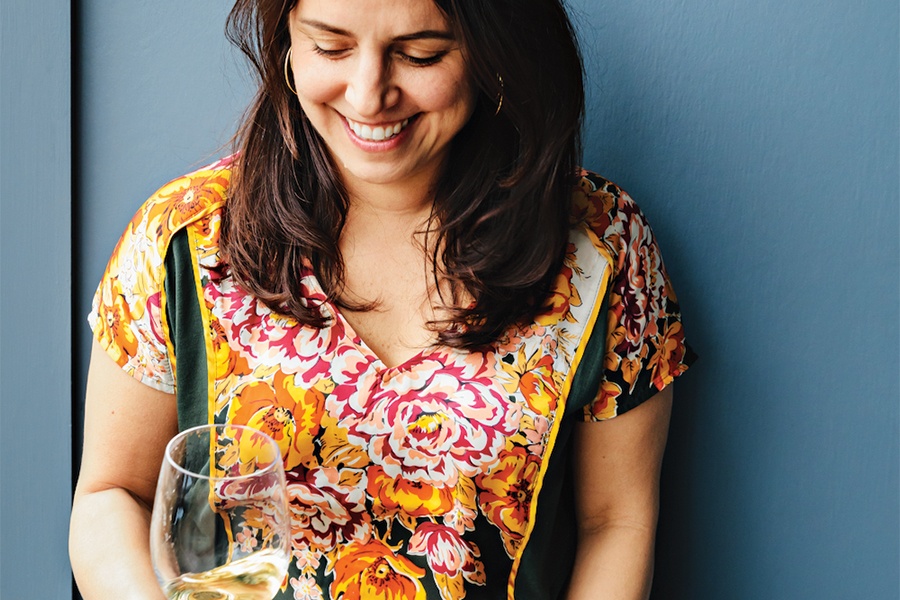Sommelier Theresa Paopao on How to Select the Perfect Bottle
What wines would a sommelier choose for a wedding? We asked an alum of Cambridge’s Oleana for recommendations.

Photo by Kristen Teig
Choosing wines can be a stressful situation. Whether you’re looking to impress a potential mate or a VIP client, selecting the perfect bottle can be a challenge—even when you have some wine knowledge. Theresa Paopao should know. The advanced sommelier spent several years guiding couples through the process when she served as wine director at Oleana in Cambridge. Currently a freelance wine consultant for regional restaurants and retailers, Paopao has also gained firsthand experience selecting wedding wines—sparkling in particular—as a recent bride herself. In fact, she hosted two weddings: an intimate family gathering in her hometown of Hilo, Hawaii, and a clambake for East Coast friends in Rhode Island. “It was two totally different kinds of planning experiences but around the same size (about 60 people),” she says. “For the former, it was a demographic that didn’t care that much about the wine I served; for the latter, the guests were all my wine and chef friends, so the pressure was on.”
How to Select Your Sparkling
First, consider if you’re going to have it for a toast or serve it for the whole event. If it’s for your wedding toast, you don’t need that much. Two ounces is a happy pour, and you can get about 10 to 12 pours out of one bottle. That math is important to keep in mind. When it comes to drinking wine for your whole event, consider how many people are beer drinkers and how many aren’t drinking, and then focus on the remainder of the guests.
Affordable Wines (around $15 and under)
You don’t have to spend a lot of money. I think giving people a handful of styles is actually an easier way for them to approach the buying process—as opposed to giving them a list of names of wines they should try to find because it’s easier to put a style into a price category. So for value wines, it’s selections such as prosecco, cava, and Blanquette de Limoux, which hails from a lesser-known area of France.
Moderately Priced (between the $18 to $25 range)
Here’s where you get into the Crémants—a wine term that refers specifically to sparkling wines made in France that aren’t part of the Champagne region. They can come from all over the country. There are also American brands, including Gruet out of New Mexico and closer to home, Westport Rivers in Massachusetts. What’s really trending right now is Pét-Nat (pétillant naturel/naturally sparkling). Producers take a bit more care in the winemaking process here while simultaneously trying to keep the wines in an affordable range because they want people to try them.
Sparkling Splurges ($50 and above)
If there’s ever a time when you should have champagne, it’s at a wedding. With a range of prices and styles available, I think it’s important to have a conversation with someone who can guide you through the buying process—either at a retail store or with a wine-knowledgeable friend—to help you narrow down the options. But grower champagne is particularly special, and you can often get a vintage date.
Retail Recommendations
Within Boston proper, the folks at the Urban Grape are doing a great job. I also like the Wine Bottega in the North End. For the suburbs, I recommend the Spirited Gourmet in Belmont, and if you’re in the Worcester area, there’s an awesome store called Milltown Wine Co.
Need help navigating the bottle-buying process? Here are a few quick insights from Theresa Paopao to get you started.
KNOW YOUR ATTENDEES
People drink less during the day than they do at night and even less when they have to work the next day, so your day of the week will influence the way people consume. They also crave colder beverages when it’s hot out, so for a daytime wedding outside during the summer, people are going to want their beverages chilled. Remember that it’s important to have non-alcoholic options available as well.
INQUIRE WITHIN
Ask questions and make sure you understand the answers, whether it’s at a retailer or at your venue. And it doesn’t hurt to do a little wine 101 beforehand so you have a sense of what the wine terms mean—just to make sure you’re on the same page.
TRY BEFORE YOU BUY
If you can try the wine before you buy it, that’s always the best option because you don’t want to get stuck with a surprise. At stores, most retailers will offer you a discount if you’re buying a case, so when you’re thinking about value, be sure to factor that in.
MAKE A CHOICE AND STICK WITH IT
People overthink it. They spend a lot of time making these choices because they’re unsure. It’s a difficult field to navigate if you don’t know the language, so be okay with making a choice and sticking with it. Honestly, people are there to celebrate, so there’s always forgiveness when it comes to the guest experience.
INSIDER SECRET
Let’s say you bought more wine than you needed. More often than not, you can return it. Ask the retailer if they’ll take it back and see what their answer is because some places will, as long as the bottle is unopened and the label looks good.
RECEPTION SAVIOR
Make sure you have plenty of ice because you can never have too much. There’s nothing worse than wines that are too warm, and there’s always going to be someone who wants to add a bit of ice to their glass. Plus, you want to make sure it’s clean—meaning it hasn’t had wine or beer bottles or anything else stuck into it.
Getting married? Start and end your wedding planning journey with Boston Weddings' guide to the best wedding vendors in the city.


